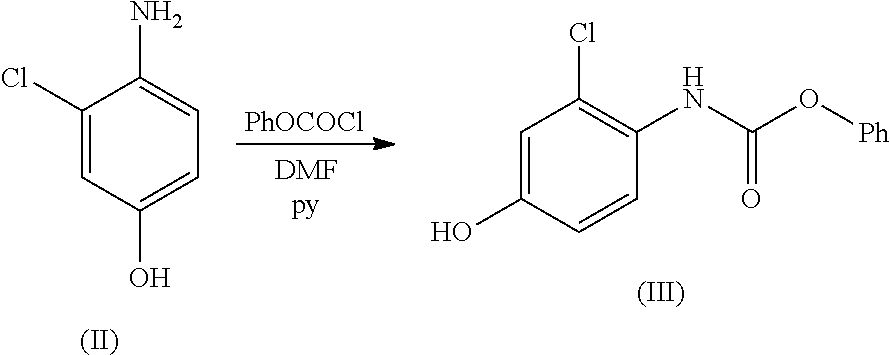Process for the preparation of lenvatinib
a technology of lenvatinib and process, which is applied in the field of process for the preparation of lenvatinib, can solve problems such as detriment, and achieve the effect of improving the
- Summary
- Abstract
- Description
- Claims
- Application Information
AI Technical Summary
Benefits of technology
Problems solved by technology
Method used
Image
Examples
example 1-1
-(2-Chloro-4-hydroxyphenyl)-3-cyclopropylurea (V)
[0018]4-Amino-3-chloro-phenol hydrochloride salt (II) (60.0 g, 333.3 mmol, 1 eq.) was suspended in 2-methyltetrahydrofuran (180 mL, 3V) and the suspension cooled at 0÷5° C. A solution of NaHCO3 (58.8 g, 699.9 mmol, 2.1 eq.) in water (650 mL) was added drop-wise in 25 min. and the temperature maintained below 10° C. A solution of phenyl chloro formate (57.4 g, 46.0 mL, 366.7 mmol, 1.1 eq.) in 2-methyltetrahydrofuran (96 mL) was added dropwise in 25 min. keeping the temperature below 10° C. The mixture was stirred at 0÷5° C. for 10 min. The reaction was monitored by quantitative TLC (95:5 DCM: MeOH; UV 254 nm) until 4-amino-3-chloro-phenol was less than 1%.
[0019]The phases were separated and removed and cyclopropylamine (IV) (37.9 g, 46.0 mL, 666.6 mmol, 2 eq.) was added drop-wise in 30 min to the organic phase maintaining the temperature below 10° C. The mixture was stirred at 50° C. for 3 h. The reaction course was monitored by quanti...
example 3-4
-(3-Chloro-4-(cyclopropylaminocarbonyl)aminophenoxy)-7-methoxy-6-quinolinecarboxamide (I)
[0025]4-chloro-7-methoxyquinoline-6-carboxamide (VI) (32.0 g, 135.2 mmol, 1 eq.) and 1-(2-chloro-4-hydroxyphenyl)-3-cyclopropylurea (V) (61.30 g, 270.4 mmol, 2 eq.) were suspended under nitrogen in DMSO (192 mL, 6V). Cesium carbonate (88.11 g, 270.4 mmol, 2 eq) was added and the mixture was stirred at 50° C. under a nitrogen atmosphere for 24 h. The reaction mixture was cooled to r.t. and water (192 mL, 6V) added drop-wise in 40 min. to precipitate the product. The obtained suspension was stirred at r.t for 1 h. The precipitated crystals were filtered off, washed with 1:1 DMSO:H2O (64 mL, 2V) and triturated three times with water (130 mL, 4V). The solid was dried at 60° C. under vacuum for 18 h to afford a light brown / grey solid (53.25 g, 124.7 mmol, y=85%, impurities content reported in Table 1). Crude Lenvatinib (53.25 g, 124.7 mmol) was dissolved in DMSO (450 mL, 5V) at 70° C. The solution wa...
example 4-crystalline form
of the mesylate salt of 4-(3-chloro-4-(cyclopropylaminocarbonyl)aminophenoxy)-7-methoxy-6-quinolinecarboxamide
[0027]Lenvatinib free base (6.81 g, 15.9 mmol, 1 eq.) obtained according to Example 3 was suspended in acetic acid (18.4 mL, 2.7 V) and methanesulfonic acid (1.0 mL, 15.9 mmol, 1 eq.) diluted in acetic acid (2 mL, 0.3V) was added. The mixture was stirred at 60° C. for 30′ to reach complete dissolution. The solution was passed through Whatman 0.2 gm filter and heated again at 60° C. Ethyl acetate (6.8 mL, 1 V) was added dropwise and the mixture cooled to 40° C. The mixture was stirred at 40° C. for 16 h and at r.t. for 1 h. The suspension was filtered and the solid washed with 3:1 acetic acid:EtOAc (6.8 mL, 1V). The wet solid (ACA-1 form, 18.25 g) was dried at 60° C. in vacuum for 72 h and at 70° C. for additional 24 h to afford the title compound as ACA-1-HT dry solid form (6.22 g, 11.9 mmol, y=75%). Typical A% HPLC purity is 99.8%.
[0028]1H-NMR (DMSO-d6) δ (ppm): 0.43 (2H, m...
PUM
| Property | Measurement | Unit |
|---|---|---|
| temperature | aaaaa | aaaaa |
| temperature | aaaaa | aaaaa |
| temperature | aaaaa | aaaaa |
Abstract
Description
Claims
Application Information
 Login to View More
Login to View More - R&D
- Intellectual Property
- Life Sciences
- Materials
- Tech Scout
- Unparalleled Data Quality
- Higher Quality Content
- 60% Fewer Hallucinations
Browse by: Latest US Patents, China's latest patents, Technical Efficacy Thesaurus, Application Domain, Technology Topic, Popular Technical Reports.
© 2025 PatSnap. All rights reserved.Legal|Privacy policy|Modern Slavery Act Transparency Statement|Sitemap|About US| Contact US: help@patsnap.com



